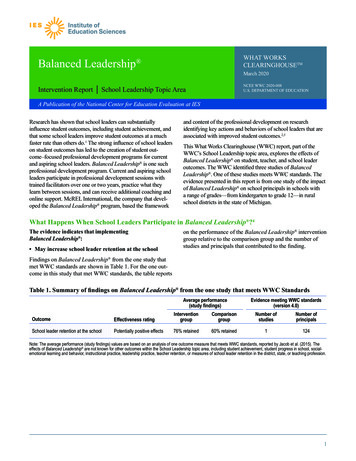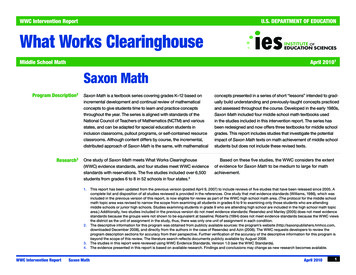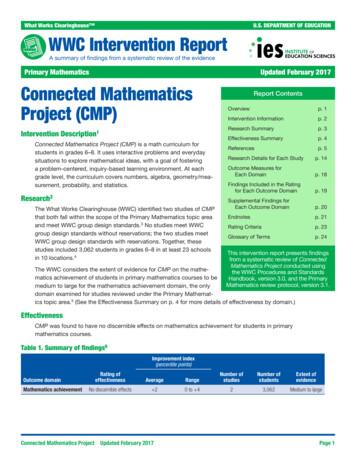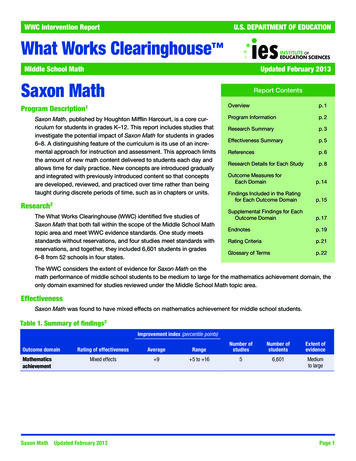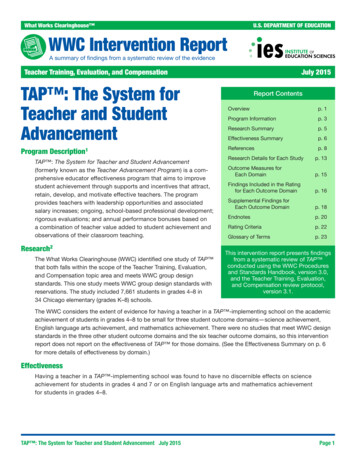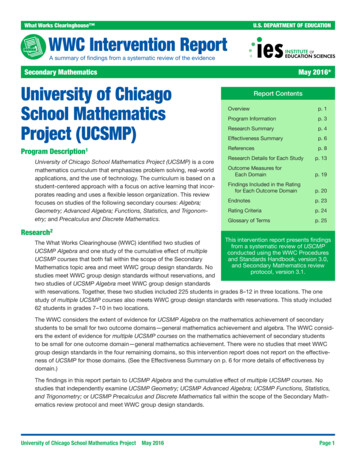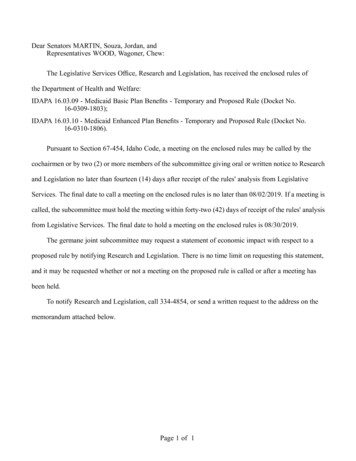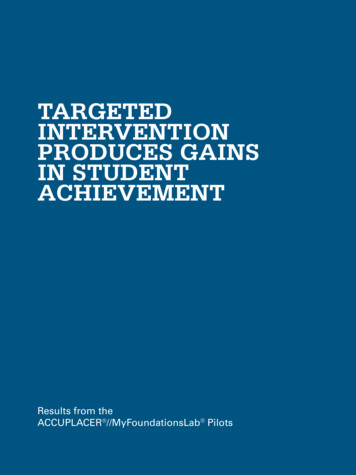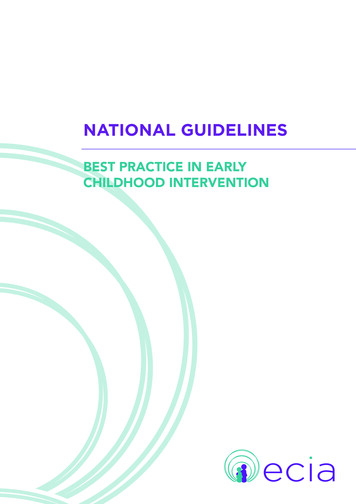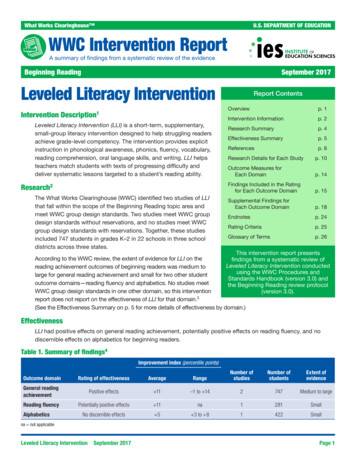
Transcription
What Works Clearinghouse U.S. DEPARTMENT OF EDUCATIONWWC Intervention ReportA summary of findings from a systematic review of the evidenceBeginning ReadingSeptember 2017Leveled Literacy InterventionIntervention Description1Leveled Literacy Intervention (LLI) is a short-term, supplementary,small-group literacy intervention designed to help struggling readersachieve grade-level competency. The intervention provides explicitinstruction in phonological awareness, phonics, fluency, vocabulary,reading comprehension, oral language skills, and writing. LLI helpsteachers match students with texts of progressing difficulty anddeliver systematic lessons targeted to a student’s reading ability.Research2The What Works Clearinghouse (WWC) identified two studies of LLIthat fall within the scope of the Beginning Reading topic area andmeet WWC group design standards. Two studies meet WWC groupdesign standards without reservations, and no studies meet WWCgroup design standards with reservations. Together, these studiesincluded 747 students in grades K–2 in 22 schools in three schooldistricts across three states.Report ContentsOverviewp. 1Intervention Informationp. 2Research Summaryp. 4Effectiveness Summaryp. 5Referencesp. 8Research Details for Each Studyp. 10Outcome Measures forEach Domainp. 14Findings Included in the Ratingfor Each Outcome Domainp. 15Supplemental Findings forEach Outcome Domainp. 18Endnotesp. 24Rating Criteriap. 25Glossary of Termsp. 26This intervention report presentsAccording to the WWC review, the extent of evidence for LLI on thefindings from a systematic review ofLeveled Literacy Intervention conductedreading achievement outcomes of beginning readers was medium tousing the WWC Procedures andlarge for general reading achievement and small for two other studentStandards Handbook (version 3.0) andoutcome domains—reading fluency and alphabetics. No studies meetthe Beginning Reading review protocolWWC group design standards in one other domain, so this intervention(version 3.0).3report does not report on the effectiveness of LLI for that domain.(See the Effectiveness Summary on p. 5 for more details of effectiveness by domain.)EffectivenessLLI had positive effects on general reading achievement, potentially positive effects on reading fluency, and nodiscernible effects on alphabetics for beginning readers.Table 1. Summary of findings4Improvement index (percentile points)Outcome domainRating of effectivenessAverageRangeNumber ofstudiesNumber ofstudentsExtent ofevidenceGeneral readingachievementPositive effects 11–1 to 142747Medium to largeReading fluencyPotentially positive effects 11na1281SmallNo discernible effects 5 3 to 81422SmallAlphabeticsna not applicableLeveled Literacy InterventionSeptember 2017Page 1
WWC Intervention ReportIntervention InformationBackgroundIrene C. Fountas and Gay Su Pinnell developed LLI in 2009; Heinemann distributes the product.Address: P.O. Box 6926, Portsmouth, NH 03802-6926. Email: fountasandpinnell@heinemann.com.Web: http://www.fountasandpinnell.com/intervention/. Telephone: (800) 225-5800.Intervention detailsLeveled Literacy Intervention (LLI) is a supplemental literacy intervention designed to help struggling readersachieve grade-level competency. LLI is delivered through explicit, direct instruction in a small-group format. Fastpaced lessons aim to engage students and promote rapid processing. Teachers can use LLI to match students tobooks that they can read without difficulty (referred to as “student’s independent level” by the developer) and tobooks that provide more challenging text (referred to as “student’s instructional level”). The developer recommendsusing Fountas & Pinnell Benchmark Assessment System (BAS) to determine the appropriate independent andinstructional levels for each student. Teachers introduce new books each day, alternating between books at astudent’s instructional and independent levels. Depending on the grade, LLI includes between 110 and 144 booksand provides references for other books with a specified reading level.Designed for students in grades K–2, the LLI Primary Systems focus on phonemic awareness, letters, phonics,comprehension, fluency, vocabulary, and writing about reading. Lessons include rereading books from the previousday, assessing reading comprehension, instructing on phonics and letters, assigning a writing task about the bookthat was read, and reading a new book. The program is intended to be delivered 30 minutes a day, 5 days a week, for12–18 weeks. The developer recommends that teachers use the LLI Primary Systems with groups of three students.Designed for students in grades 3 and 4, the LLI Intermediate Systems focus on sustained reading of longer texts.Lessons include discussing the previous day’s book and comprehension, vocabulary, and fluency practice basedon the previous day’s book; assessing reading comprehension; instruction in phonics and word study; a writingassignment about the book that was read; and reading a new book. LLI Intermediate Systems also include studylessons that focus on developing comprehension of novels and optional test preparation lessons. The programis intended to be delivered 45 minutes a day, 5 days a week, from 14 to more than 24 weeks, depending on theindividual student’s progress. The developer recommends that teachers use the LLI Intermediate Systems withgroups of four students.In general, LLI is designed for students in grades K–12 and for English learners. Although this report consideredstudies of LLI that focused on beginning readers in grades K–3, both studies that meet WWC group designstandards focused on the achievement of students in grades K–2. Therefore, this report does not present anyevidence of effectiveness for the LLI Intermediate Systems.CostAs of September 2017, depending on the system, LLI includes a selection of the following materials: (1) 4–6 copiesof each full-color book; (2) black-and-white take-home books; (3) lap books; (4) a program/system guide; (5) lessonguides; (6) writing notebooks; (7) a calculator/stopwatch; (8) Prompting Guide, Part 1 for Oral Reading & Early Writing;(9) Prompting Guide, Part 2 for Comprehension: Thinking, Talking, and Writing; (10) a professional book titled WhenReaders Struggle; (11) lesson folders; (12) student folders; (13) take-home bags; (14) access to online resources,including professional development and tutorial videos; (15) LLI Ready Resources (i.e., preprinted materials from theFountas & Pinnell website); and (16) a single 1-year teacher subscription trial to the Online Data Management System.LLI has the following costs for each system, which can be used by a single teacher or reading interventionist:Leveled Literacy InterventionSeptember 2017Page 2
WWC Intervention Report 2,900 for the LLI Orange System (Kindergarten, Levels A–E) 3,416 for the LLI Green System (Grade 1, Levels A–K) 3,324 for the LLI Blue System (Grade 2, Levels C–N) 4,950 for the LLI Red System (Grade 3, Levels L–Q)Additional subscriptions to the Fountas & Pinnell Online Data Management System are 30 per teacher, per year,which includes unlimited access for school and district administrators. An annual subscription to the Fountas &Pinnell Leveled Books website, a list of more than 50,000 titles that have been leveled using the Fountas & Pinnellframework, costs 25 and is available at http://fountasandpinnellleveledbooks.com/.Leveled Literacy InterventionSeptember 2017Page 3
WWC Intervention ReportResearch SummaryThe WWC identified 10 eligible studies that investigated the effects of LLIon the reading achievement of beginning readers. The WWC identified13 additional studies that do not meet WWC eligibility criteria (see theGlossary of Terms in this document for a definition of this term and othercommonly used research terms) for review in this topic area. Citations forall 23 studies are in the References section, which begins on p. 8.Table 2. Scope of reviewed researchGradesK–2Delivery methodSmall groupIntervention typeSupplementThe WWC reviewed 10 eligible studies against group design standards. Two studies are randomized controlledtrials that meet WWC group design standards without reservations. This report summarizes those two studies. Theremaining eight studies do not meet WWC group design standards.Summary of studies meeting WWC group design standards without reservationsRansford-Kaldon et al. (2010) conducted a randomized controlled trial of LLI on students in grades K–2 in five ruralelementary schools in Tifton, Georgia, and four suburban elementary schools in Middletown, New York. Within eachgrade, the authors matched eligible students on reading achievement and demographic characteristics. Withineach matched pair, the authors randomly assigned students to receive supplemental LLI instruction (LLI group) orno supplemental instruction in a business-as-usual condition (comparison group). They conducted the study inthe 2009–10 academic year in two stages. In fall 2009, the authors randomly assigned eligible students in grades1 and 2 to conditions; they measured the outcomes for these students in winter 2010. In winter 2010, the authorsrandomly assigned eligible kindergarten students to conditions; they assessed the outcomes of those students inspring 2010. For all grades, the intervention included 30-minute daily small-group LLI sessions in addition to theirregular classroom literacy instruction. Grade 1 and 2 students in the LLI group received, on average, 72.9 sessions.Kindergarten students in the LLI group received, on average, 37.5 sessions. The comparison group received regularclassroom literacy instruction but no additional supplemental instruction. The WWC based its effectiveness ratingon 222 students in the LLI group and 205 students in the comparison group.Ransford-Kaldon et al. (2013) conducted a randomized controlled trial of LLI on students in grades K–2 in 13 urbanelementary and K–8 schools in Denver, Colorado. Within each grade, they matched eligible students on readingachievement and demographic characteristics. Within each matched pair, the authors randomly assigned studentsto receive supplemental LLI instruction (LLI group) or to a business-as-usual comparison group. The comparisongroup students were eligible to receive any other (non-LLI) literacy intervention offered by their schools. The authorsconducted the study in the 2011–12 academic year in two stages. In fall 2011, they randomly assigned eligiblestudents in grades 1 and 2 to conditions; the authors measured outcomes for these students in winter 2012. Inwinter 2012, the authors randomly assigned eligible kindergarten students to conditions; they assessed outcomesfor those students in spring 2012. For all grades, the intervention included 30-minute daily small-group LLI sessions in addition to their regular classroom literacy instruction. Grade 1 and 2 students in the LLI group received, onaverage, 62 sessions over 18 weeks. Kindergarten students in the LLI group received, on average, 45 sessions over12 weeks. The comparison group could receive any other literacy intervention that was available at the participatingschools. The WWC based its effectiveness rating on 163 students in the LLI group and 157 students in the comparison group.Summary of studies meeting WWC group design standards with reservationsNo studies of LLI met WWC group design standards with reservations.Leveled Literacy InterventionSeptember 2017Page 4
WWC Intervention ReportEffectiveness SummaryThe WWC review of LLI for the Beginning Reading topic area includes student outcomes in four domains: generalreading achievement, reading fluency, alphabetics, and comprehension. The two studies of LLI that meet WWCgroup design standards reported findings in three of the four domains: general reading achievement, readingfluency, and alphabetics. The following findings present the authors’ estimates and WWC-calculated estimates ofthe size and statistical significance of the effects of LLI on beginning readers. Additional comparisons are availableas supplemental findings in Appendix D. The supplemental findings do not factor into the intervention’s rating ofeffectiveness. For a more detailed description of the rating of effectiveness and extent of evidence criteria, see theWWC Rating Criteria on p. 25.Summary of effectiveness for the general reading achievement domainTable 3. Rating of effectiveness and extent of evidence for the general reading achievement domainRating of effectivenessCriteria metPositive effectsIn the two studies that reported findings, the estimated impact of LLI on outcomes in the general readingStrong evidence of a positive effectachievement domain was positive and statistically significant for two studies, both of which meet WWC groupwith no overriding contrary evidence. design standards without reservations.Extent of evidenceCriteria metMedium to largeTwo studies that included 747 students in 22 schools reported evidence of effectiveness in the general readingachievement domain.Two studies that meet WWC group design standards without reservations reported findings in the general readingachievement domain.Ransford-Kaldon et al. (2010) reported grade-specific findings from the Fountas & Pinnell Benchmark AssessmentSystem (BAS). The authors reported positive and statistically significant findings for kindergarten and grade 1students; the finding for grade 2 students did not meet WWC group design standards. The WWC combined theresults across the three grades and determined that the resulting finding meets WWC group design standards.For this combined (grades K–2) sample, the WWC found a statistically significant positive difference between theintervention and comparison groups. This result was large enough to be considered substantively important. TheWWC characterizes this study finding as a statistically significant positive effect.Ransford-Kaldon et al. (2013) reported findings for three reading achievement tests—Fountas & Pinnell BAS, theDevelopmental Reading Assessment 2 (DRA2), and the STAR Early Literacy Assessment. For BAS, the authorsreported positive and statistically significant findings for students in kindergarten and grade 1 and no statisticallysignificant findings for students in grade 2. The WWC combined the results across the three grades and determinedthat the resulting finding meets WWC group design standards. For the combined (grades K–2) sample, the WWCfound a positive and statistically significant difference between the intervention and comparison groups. TheWWC-calculated effect size was large enough to be considered substantively important. For DRA2, the authorsreported positive and statistically significant findings for students in kindergarten and no statistically significantfindings for students in grades 1 and 2. The WWC combined the results across the three grades and determinedthat the resulting finding meets WWC group design standards. For the combined (grades K–2) sample, WWC founda negative but not statistically significant difference; this difference was also not large enough to be consideredsubstantively important. For STAR Early Literacy Assessment, both the combined (grades K–2) sample and theindividual grade subsamples do not meet WWC group design standards; only findings for four subgroups (grade1 female students, grade 2 female students, grade K male students, and grade 1 non-Hispanic students) meetLeveled Literacy InterventionSeptember 2017Page 5
WWC Intervention ReportWWC group design standards. The WWC combined two largest non-overlapping subgroups—grade 1 femalestudents and grade 2 female students—that, together, meet WWC group design standards. For the combined(female students in grades 1 and 2) sample, the WWC found a positive but not statistically significant difference;this difference was large enough to be considered substantively important. The WWC characterizes these studyfindings as a statistically significant positive effect.Thus, for the general reading achievement domain, two studies have a statistically significant positive effect. Thisresults in a rating of positive effects, with a medium to large extent of evidence.Summary of effectiveness for the reading fluency domainTable 4. Rating of effectiveness and extent of evidence for the reading fluency domainRating of effectivenessCriteria metPotentially positive effectsEvidence of a positive effect with nooverriding contrary evidence.In the one study that reported findings, the estimated impact of LLI on outcomes in the reading fluency domainwas statistically significant and substantively important.Extent of evidenceCriteria metSmallOne study that included 281 students in nine schools reported evidence of effectiveness in the reading fluency domain.One study that meets WWC group design standards without reservations reported findings in the readingfluency domain.Ransford-Kaldon et al. (2010) reported grade-specific findings from the Dynamic Indicators of Basic Early LiteracySkills (DIBELS) Oral Reading Fluency subtest. The authors reported positive and statistically significant differencesfor grade 1 students; the findings for grade 2 students did not meet WWC group design standards. The WWC combined the results across the two grades and determined that the resulting finding meets WWC group design standards. For the combined (grades 1–2) sample, the WWC found statistically significant positive difference betweenthe intervention and comparison groups. The WWC-calculated effect size was large enough to be consideredsubstantively important. The WWC characterizes these study findings as a statistically significant positive effect.Thus, for the reading fluency domain, one study showed a statistically significant positive effect. This results in arating of potentially positive effects, with a small extent of evidence.Summary of effectiveness for the alphabetics domainTable 5. Rating of effectiveness and extent of evidence for the alphabetics domainRating of effectivenessCriteria metNo discernible effectsNo affirmative evidence of effects.In the one study that reported findings, the estimated impact of LLI on outcomes in the alphabetics domain wasneither statistically significant nor large enough to be substantively important.Extent of evidenceCriteria metSmallOne study that included 422 students in nine schools reported evidence of effectiveness in the alphabetics domain.One study that meets WWC group design standards without reservations reported findings in the alphabetics domain.Ransford-Kaldon et al. (2010) reported grade-specific findings on DIBELS Initial Sound Fluency, Letter NamingFluency, Nonsense Word Fluency, and Phoneme Segmentation Fluency subtests. For the DIBELS Initial SoundLeveled Literacy InterventionSeptember 2017Page 6
WWC Intervention ReportFluency subtest, the authors reported, and the WWC confirmed, no statistically significant differences betweenkindergarten students in the intervention and comparison groups; the difference was also not large enough tobe considered substantively important. For the DIBELS Letter Naming Fluency subtest, the authors reported nostatistically significant difference between the intervention and comparison groups for kindergarten students but apositive and statistically significant difference for grade 1 students. The WWC combined the results across the twogrades and determined that the resulting finding meets WWC group design standards. For the combined (gradesK–1) sample, WWC found no statistically significant or substantively important difference between the interventionand comparison groups. For the DIBELS Nonsense Word Fluency subtest, the authors reported positive andstatistically significant differences between the intervention and comparison group students in the kindergartenand grade 1 samples; the findings for grade 2 students did not meet WWC group design standards. The WWCcombined the results across the three grades and determined that the resulting finding meets WWC group designstandards. For the combined (grades K–2) sample, the WWC found no statistically significant or substantivelyimportant difference between the intervention and comparison groups. For the DIBELS Phoneme SegmentationFluency subtest, the authors reported no statistically significant differences between the intervention andcomparison groups for kindergarten and grade 1 students. The WWC combined the results across the two gradesand determined that the resulting finding meets WWC group design standards. For the combined (grades K–1)sample, the WWC found no statistically significant or substantively important difference between the interventionand comparison groups. The WWC characterizes these study findings as an indeterminate effect.Thus, for the alphabetics domain, one study found an indeterminate effect. This results in a rating of no discernibleeffects, with a small extent of evidence.Leveled Literacy InterventionSeptember 2017Page 7
WWC Intervention ReportReferencesStudies that meet WWC group design standards without reservationsRansford-Kaldon, C., Flynt, E. S., Ross, C. L., Franceschini, L., Zoblotsky, T., Huang, Y., & Gallagher, B. (2010).Implementation of effective intervention: An empirical study to evaluate the efficacy of Fountas & Pinnell’sLeveled Literacy Intervention system (LLI). Memphis, TN: Center for Research in Educational Policy, Universityof Memphis. Retrieved from https://eric.ed.gov/?&id ED544374Additional source:Ransford-Kaldon, C., Flynt, E. S., & Ross, C. (2011). A randomized controlled trial of a response-to-intervention(RTI) Tier 2 literacy program: Leveled Literacy Intervention (LLI). Washington, DC: Society for Researchon Educational Effectiveness. Retrieved from https://eric.ed.gov/?&id ED518772Ransford-Kaldon, C., Ross, C., Lee, C., Sutton Flynt, E., Franceschini, L., & Zoblotsky, T. (2013). Efficacy of theLeveled Literacy Intervention System for K–2 urban students: An empirical evaluation of LLI in Denver PublicSchools. Memphis, TN: Center for Research in Educational Policy, University of Memphis.Studies that meet WWC group design standards with reservationsNone.Studies that do not not meet WWC group design standardsBecker, J. A. (2015). A program evaluation of the Leveled Literacy Intervention program among third grade students(Doctoral dissertation). Available from ProQuest Dissertations and Theses database. (UMI No. 3719143) Thestudy does not meet WWC group design standards because equivalence of the analytic intervention andcomparison groups is necessary and not demonstrated.Burns, M. K., Maki, K. E., Karich, A. C., Hall, M., McComas, J. J., & Helman, L. (2016). Problem analysis at Tier2: Using data to find the category of the problem. In S. R. Jimerson, et al. (Eds.), Handbook of response tointervention (pp. 293–307). New York, NY: Springer. The study does not meet WWC group design standardsbecause equivalence of the analytic intervention and comparison groups is necessary and not demonstrated.Burton-Archie, S. H. (2014). Reading intervention: The effectiveness of Leveled Literacy Intervention (Doctoraldissertation). Available from ProQuest Dissertations and Theses database. (UMI No. 3611522) The study doesnot meet WWC group design standards because equivalence of the analytic intervention and comparisongroups is necessary and not demonstrated.Gabriel, K. (2012). The effect of intervention programs through the response to intervention framework on first gradereading achievement (Doctoral dissertation). Available from ProQuest Dissertations and Theses database.(UMI No. 3545580) The study does not meet WWC group design standards because equivalence of theanalytic intervention and comparison groups is necessary and not demonstrated.Harvey, M. W. (2011). Union County public schools action research: Comparing early literacy interventions usedin Union County public schools; Reading Recovery vs. Leveled Literacy Intervention (Doctoral dissertation).Retrieved from https://eric.ed.gov/?&id ED522721 The study does not meet WWC group design standardsbecause equivalence of the analytic intervention and comparison groups is necessary and not demonstrated.Miller, H. T. (2014). Evaluating the effectiveness of first grade literacy interventions: Reading Recovery and LeveledLiteracy Intervention (Doctoral dissertation). Available from ProQuest Dissertations and Theses database. (UMINo. 3690941) The study does not meet WWC group design standards because equivalence of the analyticintervention and comparison groups is necessary and not demonstrated.Odell, K. (2012). The effect of Fountas & Pinnell’s Leveled Literacy Intervention on kindergarten studentsreading below grade level (Research paper, Northwest Missouri State University). Retrieved from http://www.nwmissouri.edu/ The study does not meet WWC group design standards because the measures ofeffectiveness cannot be attributed solely to the intervention.Leveled Literacy InterventionSeptember 2017Page 8
WWC Intervention ReportWard, E. (2011). Leveled Literacy Intervention: Research and data collection project 2009-2010. Portsmouth, NH:Heinemann. The study does not meet WWC group design standards because equivalence of the analyticintervention and comparison groups is necessary and not demonstrated.Studies that are ineligible for review using the Beginning Reading Evidence Review ProtocolCampbell, K. (2015). Leveled Literacy Intervention: An elementary reading intervention for English language learnernewcomers. Cross-Cultural Approaches to Language and Literacy Development, 5, 118–138. The study isineligible for review because it does not use an eligible design.Corcoran, R. P., & Ross, S. M. (2015). An evaluation of the effectiveness of the Remediation Plus program onimproving reading achievement of students in the Marinette (WI) school district. Baltimore, MD: Center forResearch and Reform in Education, Johns Hopkins University. The study is ineligible for review because it isout of scope of the protocol.Demers, L. (2012). Leveled Literacy Intervention: Research and data collection project 2010-2011. Portsmouth, NH:Heinemann. The study is ineligible for review because it does not use an eligible design.Fountas & Pinnell Literacy. (n.d.). Leveled Literacy Intervention (LLI) data analysis: Reading gains for studentsenrolled in LLI pilot 2006-2008. Portsmouth, NH: Heinemann. The study is ineligible for review because it doesnot use an eligible design.Hansen, C. (2014). The effects of self-graphing oral reading fluency in Tier 2 response-to-intervention (Doctoraldissertation). Available from ProQuest Dissertations and Theses database. (UMI No. 3685535) The study isineligible for review because it is out of scope of the protocol.Harrison, L., Peterman, R., Grehan, A., Ross, S., Dexter, E., & Inan, F. (2008, March). Evaluation of the LeveledLiteracy Intervention: Year 1. Paper presented at the annual meeting of the American Educational ResearchAssociation, New York, NY. The study is ineligible for review because it does not use an eligible design.Haupin, R. G. (2016). Improving receptive oral language skills of English language learners to enhance achievementin Reading Recovery . Available from ProQuest Dissertations and Theses. (UMI No. 10116933) The study isineligible for review because it does not use a sample aligned with the protocol.Hof-Dunn, D. C. (2015). The effect of Leveled Literacy Intervention on first and second grade student literacyachievement (Doctoral dissertation). Available from ProQuest Dissertations and Theses database. (UMI No.3712273) The study is ineligible for review because it does not use an eligible design.Mertes, L. (2015). Leveled Literacy Intervention and supports for English language learners (Doctoral dissertation).Available from ProQuest Dissertations and Theses database. (UMI No. 3700653) The study is ineligible forreview because it is out of scope of the protocol.Metz, T. J. (2014). A case study: Effects of using Leveled Literacy Intervention on fourth and fifth grade students’reading achievement (Doctoral dissertation). Available from ProQuest Dissertations and Theses database.(UMI No. 3581423) The study is ineligible for review because it does not use a sample aligned with theprotocol.Murray, M. S., Munger, K. A., & Hiebert, E. H. (2014). An analysis of two reading intervention programs: How do thewords, texts, and programs compare? The Elementary School Journal, 114(4), 479–500. The study is ineligiblefor review because it does not use an eligible design.Peterman, R., Grehan, A., Ross, S., Gallagher, B., & Dexter, E. (2009, April). An evaluation of the Leveled LiteracyIntervention program: A small-group intervention for students in K-2. Paper presented at the annual meetingof the American Educational Research Association, San Diego, CA. The study is ineligible for review becauseit does not use an eligible design.Zeng, S., Benner, G. J., & Silva, R. M. (2016). Effects of a summer learning program for students at risk foremotional and behavioral disorders. Education and Treatment of Children, 39(4), 593–615. The study isineligible for review because it does not use a sample aligned with the protocol.Leveled Literacy InterventionSeptember 2017Page 9
WWC Intervention ReportAppendix A.1: Research details for Ransford-Kaldon et al. (2010)Ransford-Kaldon, C., Flynt, E. S., Ross, C. L., Franceschini, L., Zoblotsky, T., Huang, Y., & Gallagher, B.(2010). Implementation of effective intervention: An empirical study to evaluate the efficacy ofFountas & Pinnell’s Leveled Literacy Intervention system (LLI). Memphis, TN: Center for Researchin Educational Policy, University of Memphis.Table A1. Summary of findingsMeets WWC group design standards without reservationsStudy findingsSample sizeAverage improvement index(percentile points)Statistically significantGeneral reading achievement427 students/9 schools 14YesReading fluency281 students/9 schools 11Yes
Additional subscriptions to the Fountas & Pinnell Online Data Management System are 30 per teacher, per year, which includes unlimited access for school and district administrators. An annual subscription to the Fountas & Pinnell Leveled Books website, a list of more than 50,000 titles that have been leveled using the Fountas & Pinnell
